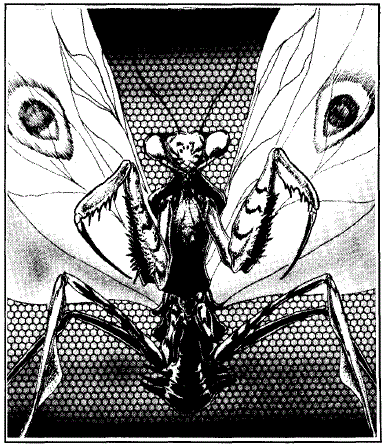
| Climate/Terrain: | Karpri |
|---|---|
| Frequency: | Rare |
| Organization: | Solitary |
| Activity Cycle: | Day |
| Diet: | Carnivore |
| Intelligence: | Animal (1) |
| Treasure: | Nil |
| Alignment: | Neutral |
| No. Appearing: | 1d2 |
| Armor Class: | 5 |
| Movement: | 15 |
| Hit Dice: | 2-12 |
| THAC0: | 2 HD: 19 4 HD: 17 6 HD: 15 8 HD: 13 10 HD: 11 12 HD: 9 |
| No. of Attacks: | 3 |
| Damage/Attack: | 2-4 HD: 1d2/1d2/1d4 6-8 HD: 1d4/1d4/1d8 10 HD: 1d6/1d6/1d10 12 HD: 1d8/1d8/1d12 |
| Special Attacks: | Nil |
| Special Defenses: | Nil |
| Magic Resistance: | Nil |
| Size: | S-M (2-5') |
| Morale: | Fearless (20) |
| XP Value: | 2 HD: 35 4 HD: 120 6 HD: 270 8 HD: 650 10 HD: 1,400 12 HD: 2,000 |
This creature is a courageous but stupid predator, appearing identical to the praying mantis found on the planet Toril, only larger - much larger. It has a soft, almost translucent, green color which allows the creature to blend well with its natural surroundings, successfully hiding 45 percent of the time. Its large forearms are covered with huge bristles which trap prey in a grip difficult to escape from. For every two Hit Dice that the gargantuan praying mantis has, anyone captured must roll a Dexterity check at -1 to escape.
The creature has a tough exoskeleton which gives it a natural Armor Class of 5. However, for every two Hit Dice over two, the Armor Class improves by one; thus, this monster would have an AC of Oat 12 Hit Dice.
Combat: This creature prefers to allow its prey to approach it, whereupon it can pounce with complete surprise. The gargantuan praying mantis clutches its quarry in its front spiny arms, inflicting the first two damages listed above. It then bites for the third damage listed above. Each size of praying mantis inflicts a different amount of damage.
When injured for half or more of its original hit points, the gargantuan praying mantis retreats immediately, to search for an easier meal. Even if the target creature is nearly dead, the mantis still retreats. Until that time comes, though, the creature never retreats and never checks for morale.
Habitat/Society: These monsters are solitary creatures who ferociously protect their hunting grounds from others of their kind. Never are two of these creatures found fighting together to bring down a large prey. In fact, mantises have been known to actually lay prey down to fight one of their own kind in order to protect their boundaries.
The only time that more than one get together in noncombative terms is when a male and female come together to mate. Even then, males fight among themselves for the mating rights to a female. Once courtship is complete, the female immediately leaves to lay her eggs. In a single laying, these female gargantuan praying mantises are known to lay more than 10,000 eggs. Out of these 10,000, nearly 8,000 are eaten before they have a chance to hatch. Out of 2,000 left, only ten are believed to make it to maturity, because they die from the territorial wars of older mantises. Out of the original 10,000 eggs laid, only three might live long enough to mate the next year.
